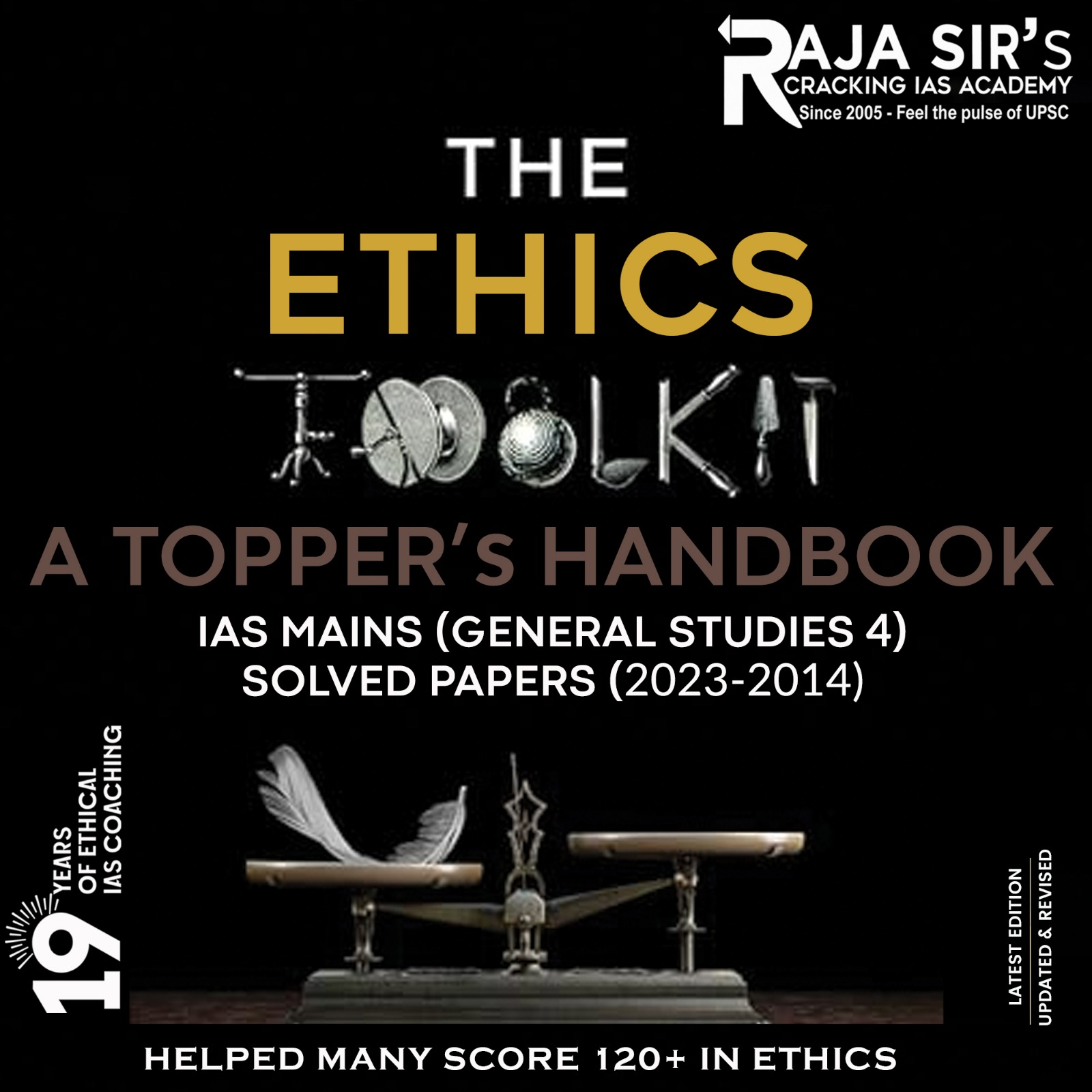- Home
- Prelims
- Mains
- Current Affairs
- Study Materials
- Test Series
 EDITORIALS & ARTICLES
EDITORIALS & ARTICLES
Hit List Questions 54-PPP 100 PRELIMS 2024 - 72
Questions & Explanations:
|
1. |
With reference to the heritage of India, consider the following statements: 1. Lambani art is a distinctive form of painting style, practiced on walls of temples in Maharashtra. 2. The indigenous Warli tribal community, are associated with Lambadi art. 3. Sandur Lambadi art from Maharashtra has been given Geographical Indication tag. How many of the statements given above is/are correct? (a) Only one (b) Only two (c) All three (d) None
|
|
2. |
“Large Language Models” seen in news refer to the context of (a) Artificial Intelligence (b) Preservation of tribal languages (c) Eco pedagogy (d) DNA Computers
|
|
3. |
Consider the following statements about PM e- Bus Sewa Scheme: 1. The approved bus scheme will augment city bus operations with 10,000 e-buses on Public Investment Model. 2. Under the program, entire subsidy will be provided by Central Government. Which of the statements given above is/are correct? (a) 1 only (b) 2 only (c) Both 1 and 2 (d) Neither 1 nor 2
|
|
4. |
Consider the following statements. 1. It is a Buddhist site. 2. It is in Arunahcal Pradesh. Which of these statements are correct w.r.t. Bordowa Than? (a) 1 only (b) 2 only (c) Both 1 and 2 (d) Neither 1 nor 2
|
|
5. |
1. Dandi March 2. Champaran Satyagraha 3. Ahmedabad mills strike 4. Kheda Satyagraha 5. Anti-Rowlatt Satyagraha How many of the above did Gandhi began from Sabarmati Ashram? (a) Only three (b) Only two (c) Only four (d) All the five |
|
6. |
Black Death is caused by (a) bacteria (b) virus (c) fungus (d) protozoa
|
|
7. |
Which of the following is/are true w.r.t. Kiru Hydel Project? 1. It is being developed over the Chenab River. 2. It is a Storage hydropower project. (a) 1 only (b) 2 only (c) Both 1 and 2 (d) Neither 1 nor 2
|
|
8. |
1. It comes into force from the date the election schedule is announced until the date that last phase of election is over. 2. It has statutory backing. 3. C-vigil application is available for citizens to report on matters of political misconduct pertaining to violation of the MCC. How many of the statements given above is/are correct w.r.t. The Election Commission’s “Model Code of Conduct (MCC)”? (a) Only 1 statement (b) Only 2 statements (c) All the 3 statements (d) None of the statements
|
|
9. |
Belem declaration deals with (a) Conservation of wetlands (b) Conservation of Amazon (c) Preservation of corals (d) Preservation of natural heritages
|
|
10. |
Consider the following statements w.r.t. Cairns Group. 1. It is a group of nations lobbying for UNSC reforms. 2. India is its member. (a) Only 1 is true (b) Only 2 is true (c) Both 1 and 2 are true (d) Neither 1 nor 2 is true
|
|
11. |
Agalega islands are located in (a) Japan (b) Srilanka (c) Mauritius (d) Finland
|
|
12. |
Consider the following statements: 1. It is composed of 15 judges. 2. Its judges are elected by the United Nations General Assembly and the Security Council. 3. Its judgments in contentious cases are final and binding on the parties to a case, and without appeal. How many of the above statements is/are correct w.r.t. International Court of Justice?. (a) Only one (b) Only two (c) All three (d) None
|
|
13. |
1. It is solar-powered. 2. It can bridge the gap in mobile networks during natural disasters. 3. It does not require a rocket to get into space. How many of the statements given above is/are correct w.r.t. “High Altitude Pseudo-Satellites”? (a) Only 1 statement (b) Only 2 statements (c) All the 3 statements (d) None of the statements
|
|
14. |
Consider the following statements about incremental cash reserve ratio: 1. It is an additional cash balance which the RBI can ask banks to maintain over and above the CRR - for a specific period. 2. It reduces the surplus liquidity in the banking system. Which of the statements given above is/are correct? (a) 1 only (b) 2 only (c) Both 1 and 2 (d) Neither 1 nor 2
|
|
15. |
Consider the following statements w.r.t. Similipal Tiger Reserve. 1. It is the India’s only wild habitat for melanistic royal Bengal tigers. 2. Sal is the dominant tree species in it. (a) Only 1 is true (b) Only 2 is true (c) Both 1 and 2 are true (d) Neither 1 nor 2 is true
|
|
16. |
I. crowding out of private investment II. devaluation of the currency What would be the impact of very high fiscal deficit? (a) Only I (b) Only II (c) Both I & II (d) Neither I nor II
|
|
17. |
Carmoisine and Carmine in news refer to (a) approved synthetic colours (b) unapproved synthetic colours (c) approved artificial sweetners (d) unapproved artificial sweetners
|
|
18. |
Which of the following is/are true w.r.t. retail inflation? 1. It is currently based on a basket that was decided in 2012. 2. It is WPI based. (a) 1 only (b) 2 only (c) Both 1 and 2 (d) Neither 1 nor 2
|
|
19. |
Consider the following statements regarding Duchenne Muscular Dystrophy (DMD): 1. It is a genetic rare disease which primarily impacts male children. 2. It is caused by an excessive production of dystrophin. Which of the statements given above is/are correct?. (a) 1 only (b) 2 only (c) Both 1 and 2 (d) Neither 1 nor 2
|
|
20. |
The test of proportionality is a commonly employed legal method used by courts w.r.t. the issue of (a) Fundmaental Duties (b) Fundmaental Rights (c) Judicial adventurism (d) Office of Profit
|
|
21. |
Silencing of a gene could be achieved through the ụse of (a) Short interfering RNA (b) Antisense RNA (c) Both (a) & (b) (d) Neither (a) Nor (b)
|
|
22. |
Identify the wrong statement with reference to transport of oxygen. (a) Higher H+ conc. In alveoli favours the formation of oxyhaemoglobin (b) Low pCO2 in alveoli favours the formation of oxyhaemoglobin (c) Binding of oxygen with haemoglobin is mainly related to partial pressure of O2 (d) Partial pressure of CO2 can interfere with O2 binding with haemoglobin
|
|
23. |
Taraori and Dehraduni are examples of (a) traditional basmati varieties (b) low glycemic wheat varieties (c) golden rice varieties fortified with Vitamin A (d) drought proof wheat varieties
|
|
24. |
How is FRP different from MSP? 1. While MSP is fixed by Union government, FRP is fixed by State government. 2. MSP is an obligatory exercise and FRP is a statutory exercise. (a) Only 1 is true. (b) Only 2 is true. (c) 1 & 2 are true (d) Neither 1 nor 2 is true
|
|
25. |
Which one of the following statements is incorrect w.r.t. “Radiative forcing”? (a) It is quantified at the tropopause. (b) Negative radiative forcing warms the earth. (c) Both (a) and (b) (d) Neither (a) nor (b) |
EXPLANATIONS
|
1. |
7th August is declared as the National Handloom Day. It was in 1905 that the Swadeshi Movement was launched on the same day. · The Lambani embroidery is an intricate form of textile embellishment characterized by colourful threads, mirror-work and stitch patterns. · It is practiced in several villages of Karnataka such as Sandur, Keri Tanda, Mariyammanahalli, Kadirampur etc. · The Lambani craft tradition involves stitching together small pieces of discarded fabric to create a beautiful fabric. · This embroidery had also found a place in the list of products with Geographic Indication (GI) tag in the country. · The Lambanis are also known as Banjaras and most of them are found in Telangana, Andhra Pradesh and Karnataka states in South India. · This community settled across the country with different names, have permanently abandoned their nomadic lifestyle and settled in their settlements called Tandas. · They speak Gor Boli also called Lambadi which belongs to the Indo-Aryan Group of Languages. Lambadi has no script. · They celebrate the festival of Teej during Shravanam (in the month of august). In this festival young unmarried Banjara girls pray for a good groom. · Fire dance and Chari are the traditional dance forms of the banjara people. |
D |
|||||||||||||||||||||
|
2. |
A |
||||||||||||||||||||||
|
3. |
https://pib.gov.in/PressReleaseIframePage.aspx?PRID=1949430 · Public Investment Model: For a government to invest, it needs revenue (mainly tax revenue), but the present tax revenues of India are not sufficient enough to meet the budgetary expenditure of India. So India cannot move ahead in the path of growth without private individuals; even for government to have a share in the investment, they need tax revenue from the private investors. · Private Investment Model: The private investment can come from India or abroad. If it’s from abroad – they can be as FDI or FPI. (Details will be discussed later.) As India’s Current Account Deficit is widening due to increased Oil Import, in this age of globalization, we cannot say NO to FDI or FPI. Why private investment in India: For a country to grow and increase its income, the production has to be increased. More goods and services has to be produced. Infrastructure to support production – transport, energy and communication – should also be developed. But how can a nation with near 30% of population below poverty line, invest in production or infrastructure? · Public Private Partnership Model: PPP means combining the best benefit from both public and private investments. Some of the Project Finance Schemes are as below: 1. BOT (build–operate–transfer). 2. BOOT (build–own–operate–transfer). 3. BOO (build–own–operate). 4. BLT (build–lease–transfer). 5. DBFO (design–build–finance–operate). 6. DBOT (design–build–operate–transfer). 7. DCMF (design–construct–manage–finance). Again, depending from where investment comes, there are two other investment models. Domestic Investment Model – It can be from Public, Private or PPP. Foreign Investment Model – It can be 100% FDI or Foreign-Domestic Mix. And, depending on where the investment goes (or how investments are planned), there are various investment models. A few include: Sector Specific Investment Models (In SEZ or MIZ etc). Cluster Investment Model (Eg: Food Processing Industries)
|
D |
|||||||||||||||||||||
|
4. |
D |
||||||||||||||||||||||
|
5. |
D |
||||||||||||||||||||||
|
6. |
A |
||||||||||||||||||||||
|
7. |
Run-of-river hydropower: a facility that channels flowing water from a river through a canal or penstock to spin a turbine. Typically a run-of-river project will have little or no storage facility. Run-of-river provides a continuous supply of electricity (base load), with some flexibility of operation for daily fluctuations in demand through water flow that is regulated by the facility. Storage hydropower: typically a large system that uses a dam to store water in a reservoir. Electricity is produced by releasing water from the reservoir through a turbine, which activates a generator. Storage hydropower provides base load as well as the ability to be shut down and started up at short notice according the demands of the system (peak load). It can offer enough storage capacity to operate independently of the hydrological inflow for many weeks or even months. |
A |
|||||||||||||||||||||
|
8. |
It comes into force from the date the election schedule is announced until the date that results are out. It has no statutory backing. |
A |
|||||||||||||||||||||
|
9. |
B |
||||||||||||||||||||||
|
10. |
It is a group of agricultural exporting nations lobbying for agricultural trade liberalization. |
D |
|||||||||||||||||||||
|
11. |
C |
||||||||||||||||||||||
|
12. |
International Court of Justice (ICJ):
o First, it can act as a dispute settlement body between two member States in what are called “contentious cases.” Such disputes may concern, in particular, land frontiers, maritime boundaries, territorial sovereignty, the non-use of force, violation of international humanitarian law, non-interference in the internal affairs of States and diplomatic relations. o Second, it can accept requests to issue an advisory opinion on a legal questionreferred to it by aUN body or specialized agency. These opinions can clarify the ways in which such organizations may lawfully function or strengthen their authority in relation to their member States. o The court''s judgments in contentious cases are final and binding on the parties to a case, and without appeal. o Unlike the Court’s judgments, advisory opinions are not binding. o The ICJ decides disputes in accordance with international law as reflected in international conventions, international custom, general principles of law recognized by civilized nations, judicial decisions, and the writings of the most highly qualified experts on international law. Composition: o It consists of 15 judges, all from different countries, who are elected tonine-year termsby majority votes in the UN General Assembly and the Security Council. o The judges, one-third of whom are elected every three years, are eligible for reelection. o Once elected, a member of the Court is a delegate neither of the government of his own country nor of any other State. o In addition, the ICJ Statute allows a state partyto a case before it which does not have a judge of its nationality on the bench to appoint a person to sit as judge ad hoc in that specific case. o The Court is assisted by a Registry, its permanent administrative secretariat, which is independent of the United Nations Secretariat. International Criminal Court (ICC) It is the only permanent international criminal tribunal. It was created by the 1998 Rome Statute of the International Criminal Court , and began functioning on 1 July 2002. It investigates and, where warranted, tries individuals charged with the gravest crimes of concern to the international community: genocide, war crimes, crimes against humanity, and the crime of aggression.Unlike the International Court of Justice, which hears disputes between states, the ICC handles prosecutions of individuals. While not a United Nations organization, the Court has a cooperation agreement with the United Nations. |
C |
|||||||||||||||||||||
|
13. |
C |
||||||||||||||||||||||
|
14. |
Cash Reserve Ratio (CRR)
I-CRR
I-CRR Needed
I-CRR Discontinued?
How the Amount Impounded under the I-CRR would be Released?
|
C |
|||||||||||||||||||||
|
15. |
https://indianexpress.com/article/explained/similipals-black-tigers-female-big-cats-9194056/ Simlipal Tiger Reserve (STR) · Location: STR is located within the Mayurbhanj District, in the Northernmost part of Odisha. · It is surrounded by high plateaus and hills, the highest peak being the twin peaks of Khairiburu and Meghashini (1515m above mean sea level). · It was declared a ''Tiger Reserve'' in the year 1956 and included under the national conservation programme ''Project Tiger'' in 1973. · The STR, along with a ''transitional area'' of 2250 sq. km, was included as a part of the World Network of Biosphere Reserves by UNESCO in the year 2009. · Terrain: The terrain is mostly undulating and hilly, interspersed with open grasslands and wooded areas. · Vegetation: It is a mix of different forest types and habitats, with Northern tropical moist deciduous dominating some semi-evergreen patches. · It is the only landscape in the world that is home to melanistic tigers. · The region around STR is home to a variety of tribes, including Kolha, Santhala, Bhumija, Bhatudi, Gondas, Khadia, Mankadia and Sahara. · Flora: · An astounding 1078 species of plants, including 94 species of orchids, are found here. · Sal is the dominant tree species here. [Dry deciduous forests are found in areas having rainfall between 70 cm and 100cm. These forests are found in the rainier parts of the peninsular plateau and the plains of Bihar and Uttar Pradesh. Teak, Sal, Peepal, and Neem are the most dominant species of this forest.] · Fauna: Leopard, Gaur, Elephant, Langur, Barking and Spotted Deer, Sloth Bear Mongoose, Flying Squirrel, Porcupine, Turtle, Monitor Lizard, Python, Sambar, Pangolin etc. |
C |
|||||||||||||||||||||
|
16. |
· Fiscal deficit is the difference between the government''s total expenditure and its total revenue (excluding borrowings). It is an indicator of the extent to which the government must borrow in order to finance its operations and is expressed as a percentage of the country''s GDP. · A high fiscal deficit can lead to inflation, devaluation of the currency and an increase in the debt burden. While a lower fiscal deficit is seen as a positive sign of fiscal discipline and a healthy economy. Positive Aspects of Fiscal Deficit: · Increased Government Spending: Fiscal deficit enables the government to increase spending on public services, infrastructure, and other important areas that can stimulate economic growth. · Finances Public Investments: The government can finance long-term investments, such as infrastructure projects, through fiscal deficit. · Job Creation: Increased government spending can lead to job creation, which can help reduce unemployment and increase the standard of living. Negative Aspects of Fiscal Deficit: · Increased Debt Burden: A persistent high fiscal deficit leads to an increase in government debt, which puts pressure on future generations to repay the debt. · Inflationary Pressure: Large fiscal deficits can lead to an increase in money supply and higher inflation, which reduces the purchasing power of the general public. · Crowding out of Private Investment: The government may have to borrow heavily to finance the fiscal deficit, which can lead to a rise in interest rates, and make it difficult for the private sector to access credit, thus crowding out private investment. · Balance of Payments Problems: If a country is running large fiscal deficits, it may have to borrow from foreign sources, which can lead to a decrease in foreign exchange reserves and put pressure on the balance of payments. |
C |
|||||||||||||||||||||
|
17. |
A |
||||||||||||||||||||||
|
18. |
o Retail inflation, also known as Consumer Price Index (CPI) inflation, tracks the change in retail prices of goods and services which households purchase for their daily consumption. o CPI is calculated for a fixed basket of goods and services that may or may not be altered by the government from time to time. o The change in the price index over a period of time is referred to as CPI-based inflation, or retail inflation. o What Does the CPI tell? Following are a few things that the CPI index interprets:
o CPI is calculated as a percentage. It is a comparison of the general price level in the markets in a particular time period from a time frame in the past. This is known as the base year. o CPI, therefore, is calculated by referring to a base year, which is a benchmark. Currently, the base year is 2012. o The formula for calculating the CPI index is: o CPI = (Cost of a Fixed Basket of Goods and Services in the Current Year/Cost of a Fixed Basket of Goods and Services in the Base Year) * 100 o The National Statistical Office (NSO), Ministry of Statistics and Programme Implementation (MoSPI), compiles All India as well as state-wise CPI for Rural, Urban, Combined sectors and releases the CPI numbers every month.
o It is used as a macroeconomic indicator of inflation, as a tool by the central bank and government for inflation targeting and for inspecting price stability, and as a deflator in the national accounts. o CPI also helps understand the real value of salaries, wages, and pensions, the purchasing power of the nation’s currency, and regulating rates. Wholesale Price Index o It measures the changes in the prices of goods sold and traded in bulk by wholesale businesses to other businesses. o Published by the Office of Economic Adviser, Ministry of Commerce and Industry. o It is the most widely used inflation indicator in India. o Major criticism for this index is that the general public does not buy products at wholesale price. |
A |
|||||||||||||||||||||
|
19. |
A |
||||||||||||||||||||||
|
20. |
B |
||||||||||||||||||||||
|
21. |
Gene silencing is a negative feedback mechanism that regulates gene expression to define cell fate and also regulates metabolism and gene expression throughout the life of an organism. In plants, gene silencing occurs via transcriptional gene silencing (TGS) and post-transcriptional gene silencing (PTGS). RNA interference (RNAi) is a naturally occurring post-transcriptional mechanism found in nearly all cells. It was discovered by Andrew Fire and Craig Mello in 2006. RNAi is a gene silencing or gene knockdown technology working at the RNA level. It targets the organism''s own mRNA sequence and interferes with protein synthesis. RNA interference acts as a mode of gene regulation or works as a defense mechanism against any exogenous pathogenic RNA. RNAi is also employed in genetic engineering to artificially suppress particular genes. This technique has proven instrumental in various applications, including the study of gene function, cancer therapy, control of viral infections, advancements in agricultural biotechnology, etc. Methods involved in RNA Interference There are three methods of RNAi technology, i.e., RNa-based RNAi, DNA-based RNAi and CRISP-mediated RNAi. In which RNA based RNAi is the natural process that occurs in almost all Eukaryotic cells. RNA based RNAi RNA based RNAi involves the use of small interfering RNA (SiRNA) or micro RNA (miRNA). It is produced from the cleavage of double stranded RNA (dsRNA) molecules to interfere with the translation of m-RNAs to proteins, ultimately influencing gene expression. The mechanism of RNA based RNAi involves:
DNA-based RNA Interference In DNA-based gene silencing, a short DNA sequence is used artificially to target specific RNA molecules by activating the cell’s natural RNAi pathway.
CRISPR-mediated RNAi Unlike traditional CRISPR, which cuts the specific location in the double-stranded DNAs, CRISPR interference is used in the RNAi mode of gene silencing.
Note: CRISPR-Cas9 is a gene editing tool, which can also be used for gene silencing, but at the DNA level. Hence, it does not come under the aegis of the RNAi. Applications of RNA Interference (RNAi) RNA based gene silencing or gene knockdown (RNAi) has the potential to be used in various applications, both in biomedical research and functional genomics. Some of these applications are being described here.
Limitations of RNA Interference (RNAi) The use of RNA interference (RNAi) technology comes with some challenges, which are as follows:
Gene Knockdown vs. Gene Knockout The following are the differences between Gene Knockdown and Gene Knockout:
|
C |
|||||||||||||||||||||
|
22. |
RBCs contain haemoglobin, a red-colored iron-containing pigment. O2 can attach to haemoglobin and generate oxyhaemoglobin in a reversible manner. The partial pressure of O2 is the most important factor in oxygen binding to haemoglobin. Other factors that can interfere with this binding include CO2 partial pressure, hydrogen ion concentration, and temperature. The parameters are all favourable for the synthesis of oxyhaemoglobin in the alveoli, which have a high pO2, low pCO2, reduced H+ content, and lower temperature. The circumstances for dissociation of oxygen from oxyhaemoglobin are favourable in tissues with low pO2, high pCO2, high H+ content, and higher temperature. The parameters are all favourable for the synthesis of oxyhaemoglobin in the alveoli, which have a high pO2, low pCO2, reduced H+ content, and lower temperature. The partial pressure of O2 is the most important factor in oxygen binding to haemoglobin. Other factors that can interfere with this binding include CO2 partial pressure, hydrogen ion concentration, and temperature. The partial pressure of O2 is the most important factor in oxygen binding to haemoglobin. Other factors that can interfere with this binding include CO2 partial pressure, hydrogen ion concentration, and temperature. Lower concentration of H+ ion in alveoli favours the formation of oxyhaemoglobin.
|
A |
|||||||||||||||||||||
|
23. |
A |
||||||||||||||||||||||
|
24. |
https://indianexpress.com/article/explained/everyday-explainers/frp-msp-difference-9178410/
|
B |
|||||||||||||||||||||
|
25. |
https://www.vedantu.com/geography/radiative-forcing
|
B |









 Latest News
Latest News



 General Studies
General Studies